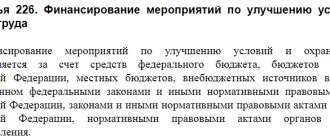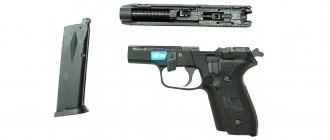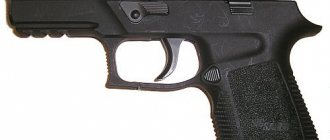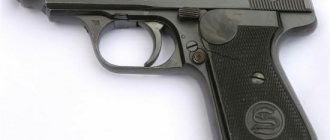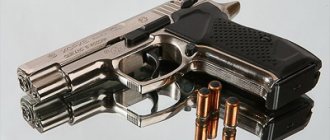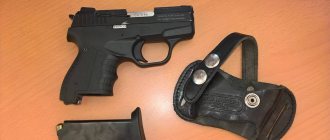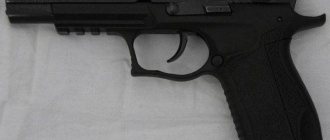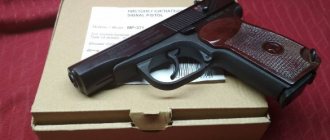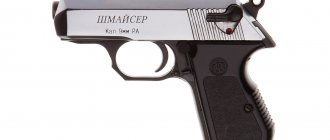Swiss-German semi-automatic pistol
Type of semi-automatic pistol
| SIG Sauer P220 | |
| The original production SIG Sauer P220 is equipped with a heel-mounted magazine release lever. Two views of the same Swiss Army pistol, displayed in the museum of the Château de Morges. | |
| Type | Semi-automatic pistol |
| Place of origin | West Germany Switzerland |
| Service history | |
| In service | 1975–present |
| Used | See Users |
| Production history | |
| Designer | Walter Ludwig, Hanspeter Sigg, Eduard Brodbeck |
| Designed by | 1975 |
| Manufacturer | SIG Sauer |
| Options | View options |
| Characteristics | |
| Weight |
|
| Length | 196 mm (7.7 in) |
| Barrel length | 112 mm (4.4 in) |
| Width | 38 mm (1.5 in) |
| Height | 140 mm (5.5 in) |
| Cartridge |
|
| Action | Short recoil |
| Feeding system | Detachable box magazine holds 6 rounds (compact "CCW" models), 7 rounds (flush with grip), 8 rounds (current extended baseplate for full-size P220 models), or 10 rounds (extended with cased case) (in .45 ACP); 9-round magazine in other calibers, with the exception of .22lr modifications, which use a 10-round magazine. |
Control part and parts on the P226 that are identical to most P220 variants: 1. Ejector port/locking lug, 2. Rear sights, 3. Hammer, 4. Takedown lever, 5. Decocker, 6. Auto-stop, 7. Trigger , 8. Magazine release (on some P220 it is located at the bottom of the handle).
SIG Sauer P220
is a semi-automatic pistol. Developed in 1975 by the SIG Arms AG division of Schweizerische Industrie Gesellschaft (now SIG Holding AG) and manufactured by JP Sauer & Sohn in Eckernförde; it is currently produced by both SIG Sauer companies: SIG Sauer GMBH, Eckernförde, Germany; and SIG Sauer, Inc., New Hampshire, USA. [1]
History[edit]
Not to be confused with the SIG P210 series, which licensed the Petter-Browning system to the French SACM in 1938, the SIG Sauer P220 was designed for release in 1975 to the Swiss Army as a replacement for the SIG P210, [2] which had been developed during World War II ; in service it is known as the "Pistole 75" (P75). For commercial production and distribution of the P220, SIG entered into a partnership with JP Sauer & Sohn of Germany, thus the P220 and all subsequent pistols from SIG and JP Sauer & Sohn are known as SIG Sauer pistols
. [1]
In 1975, Switzerland became the first country to officially adopt the P220 as the "Pistole 75" (P75) chambered in 9mm Parabellum. Other countries that have adopted it for military use include Japan (a common issue) and Denmark (which has an earlier version of the P210 in general issue) for special forces only. It was followed by a SIG Sauer P226 with a double magazine.
Upon completion of military service, all soldiers can obtain ownership of their military weapons for a nominal fee; in particular, officers and men of the Swiss Armed Forces medical forces can obtain ownership of their P220 service pistols by paying an administration fee of thirty Swiss francs. [3]
In the United States, this pistol was originally sold in a modified form under the name Browning BDA
from 1977 to 1980 [4].
P220 SIG-Sauer (P220 SIG-Sauer)
Pistol P-220 SIG-Sauer (P-220 SIG-Sauer)
P220 SIG-Sauer (P220 SIG-Sauer) is a Swiss semi-automatic pistol, a deep modification of the P210 SIG pistol, created (SIG-Sauer) in 1974.
| Ammo | 9x19 mm Parabellum |
Tactical and technical characteristics of the pistol P220 SIG-Sauer (P220 SIG-Sauer)
Length 198 mm Weight without cartridges 830 g Barrel 112 mm, 6 rifling (right-handed) magazine , box-type, capacity 9 rounds Muzzle velocity 345 m/s
(SIG) is in a rather unenviable position. It produces some of the best firearms in the world, but due to the political positions of the Swiss government, its ability to export its own products is significantly limited. As evil tongues say, it is allowed to sell weapons only to those people who do not need them. Thanks to SIG's cooperation with the German company (JP Sauer & Sohn), its pistols can be produced in Germany, where laws regulating the export of weapons are less stringent. This helps expand markets for SIG pistols. The design of the weapons produced jointly by the two companies is almost completely identical to the design of the SIG pistols, although cooperation with Sauer has led to the presence of some features in the modification compared to the original SIG pistol models.
Pistol P-220 SIG-Sauer (P-220 SIG-Sauer) and magazine for it
P220 SIG- pistol model is actually the result of a modification of the P210 SIG pistol (SIG P210), designed to make it easier to handle and cheaper to manufacture. The P220 SIG-Sauer pistol retains the usual barrel length, but the pistol's slide stop mechanism is simpler: a special square-shaped device, located next to the chamber, fits into an expanding hole in the slide, resulting in a delay.
Pistol P-220 SIG-Sauer, rear view
Instead of the usual conveyor, the assembly of the new P220 SIG-Sauer pistol model is fully automated. After careful testing and selection of components, assembly is carried out on equipment controlled by computer programs.
The trigger mechanism of the P220 SIG-Sauer pistol is double-action, but is equipped with a pre-cocking lever, which is located on the left side of the frame and allows you to safely cock the hammer and then fire like a single-action pistol .
The P220 SIG-Sauer pistol has an automatic firing pin lock that allows the firing pin to move only when the trigger is fully pressed. Due to these features, this pistol model does not have a manual safety on the pistol frame.
The P220 SIG-Sauer pistol was adopted by the Swiss army as the Pistole 75. It is used by the Japanese Self-Defense Forces, as well as in Chile, Iran, Nigeria, Uruguay and special forces personnel.
Options for the P220 SIG-Sauer pistol
Pistol P-220 Nitron (P220 Nitron)
SIG- P220 Nitron is a 1976 version of the .45 ACP pistol. The pistol frame is made of light alloy. The shutter casing is made of stainless steel with a hard wear-resistant “Nitron” coating. The P-220 Nitron pistol is equipped with a safety trigger release lever, which disconnects the sear from the cocking slot, automatic firing pin blocking and a trigger disconnector.
Tactical and technical characteristics of the SIG-Sauer P220 Nitron pistol (SIG-Sauer P220 Nitron)
Caliber .45 ACP Length 196 mm Height 140 mm Thickness 33 mm Weight g Barrel 112 mm, 6 rifling (right-handed) Aiming line 160 mm magazine , box type, capacity 8 rounds Muzzle velocity 260 m/s
Pistol SIG Sauer P-220 X-Six (SIG Sauer P-220 X-Six)
SIG Sauer P220 X-Six (SIG Sauer P220 X-Six) is a pistol version with an extended barrel and a bolt housing, as well as adjustable sights. The gun is made of stainless steel. The trigger is adjustable.
Tactical and technical characteristics of the SIG Sauer P220 X-Six pistol (SIG Sauer P220 X-Six)
Caliber .45 ACP Length 252 mm Height 145 mm Thickness 44 mm Weight 1248 g Barrel 153 mm Removable magazine
Pistol P220 Legion (P220 Legion) caliber .45 ACP
SIG- P220 Legion is a version of the pistol with a Legion coating and a G-10 grip. The shutter casing is made of stainless steel, the frame is made of light alloy. The pistol has an improved SRT (Short-Reset Trigger) trigger.
Tactical and technical characteristics of the SIG-Sauer P220 Legion pistol (SIG-Sauer P220 Legion)
Pistol P220 Legion (P220 Legion) caliber 10mm Auto
Caliber .45 ACP / 10mm Auto Length 196 mm / 224 mm Height 140 mm Thickness 34 mm / 33 mm Aiming line 160 mm / 178 mm Weight 862 g / 1250 g Barrel 112 mm / 127 mm magazine , box type, capacity of 8 rounds
SIG-Sauer P220 Legion Carry SAO (SIG-Sauer P220 Legion Carry SAO) is a compact version of the pistol with a stainless steel slide and a light alloy frame.
Tactical and technical characteristics of the SIG-Sauer P220 Legion Carry SAO pistol (SIG-Sauer P220 Legion Carry SAO)
Pistol P220 Legion Carry SAO (P220 Legion Carry SAO)
Caliber .45 ACP Length 180 mm Height 140 mm Thickness 38 mm Aiming line 145 mm Weight 861 g Barrel 99 mm magazine , box type, capacity of 8 rounds
SIG- Sauer P220 Nightmare (Horror, Nightmare) - a variant of the pistol, made in the black “Nightmare” color. The control levers and trigger are made in light colors with a nickel plated finish.
Tactical and technical characteristics of the SIG-Sauer P220 Nightmare pistol
Pistol SIG-Sauer P220 Nightmare (SIG-Sauer P220 Nightmare)
Caliber .45 ACP Length 196 mm Height 140 mm Thickness 36 mm Aiming line 160 mm Weight 862 g Barrel 112 mm magazine , box type, capacity of 8 rounds
Design[edit]
The P220 was developed in 1975 by SIG and manufactured and distributed by JP Sauer & Sohn. A new locking system was introduced, known as the SIG Sauer system,
as well as a number of other innovations. This nomenclature is found on the P220 model from Browning BDA, sold since 1975.
The SIG P210 (currently produced as the SIG Sauer P210 in the United States) is a licensed copy of the French Model 1935, which is a Petter Browning design. Petter removed the loose barrel bushing and selector link of the John Browning M1907 design, but retained the grooves on the top of the barrel that fit into similar grooves inside the bolt. SIG licensed this design in 1947.[5]
The SIG Sauer design has no grooves in the slide or barrel. Instead, the enlarged camera locks directly onto the shutter ejection port. The P220's double/single action (DA/SA) trigger design is also a SIG Sauer innovation, similar to the JP Sauer & Sohn 38H pistol. Further design improvements include a hammer release lever and a firing pin block safety. [5] [6]
Instead of locking lugs and notches milled into the barrel and slide of Browning-derived weapons such as the Colt M1911A1, Browning Hi-Power, and CZ 75, P220 variants (and many other modern pistols) lock the barrel and slide together using an enlarged barrel breech , locked in the ejection channel. The SIG Sauer system (embossed on the side of the Browning BDA) is an improvement on the Petter-Browning system. [5]
Further information: SIG Sauer System
The P220 series action is a stamped piece of thick sheet metal with a welded nose piece to an internal barrel bushing. The bolt portion is a machined insert attached to the slide with a roller pin visible from either side. The frame is made of forged alloy with a hard anodized finish. The SIG P220 series includes a hammer release lever on the rear left side of the trigger, which first appeared on the pre-World War II Sauer 38H. Once the cartridge is refilled, the hammer will be cocked, so for safe transport, the impact hammer is released using the thumb, which ensures the hammer drops safely. [5]
The P220 also features an automatic firing pin locking safety that is activated by a trigger mechanism similar to that used on the post-World War II Czech CZ-038. The pistol can now be holstered and fired without engaging any other controls. The first shot will be fired in double action unless the user chooses to manually cock the hammer. Double-action trigger pressure is approximately 12-14 pounds, with subsequent shots fired in single-action mode with a lighter trigger pressure of approximately 6 pounds. There is no separate safety lever to manipulate; Hammer drop is the only manual safety device. As with other double-action pistols such as the Walther P38 and Beretta 92F, some training is required to minimize the difference caused by the differential trigger pressure between the first shot of a double-action and subsequent single-action shots when the hammer is cocked by moving the bolt rearward. [5]
SIG Sauer calls its safety systems the “four-point system.” Four types of security:
- an automatic switch that allows the shooter to safely lower the hammer while there is a round in the chamber. When decocking occurs, the hammer drops, but it is still kept away from the firing pin.
- The safety notch prevents the trigger from accidentally hitting the firing pin.
- The hammer has its own safety that prevents the pin from moving forward. That is, until the trigger is pulled, at which point the safety is released and the pin is pulled forward to meet the cartridge primer. This third safety is also protection against falling weapons. Even when dropped from a reasonable height with a cartridge in the chamber, the gun will not fire.
- the bolt has a recess separating the firing pin from the cartridge. Unlike the aforementioned firing pin safety, this safety is designed to prevent the pistol from accidentally firing while cycling. This is called a "trigger disconnector". [7]
Army and weapons
The SIG P220 is a semi-automatic pistol developed by the Swiss (in the USA, SIG Arms AG distributed its products through its subsidiary SIG Sauer). The pistols were produced in Eckenförde, Germany as a result of cooperation between the author's company and the German J.P. Sawyer and Sohn GmbH (Gesellschaft mit beschränkter Haftung). The creation used a Browning self-loading system with a short barrel stroke. The P220 became the basis for a large family of pistols, including the P225, P226, P228 and P229. This weapon enjoys great success in the service of law enforcement agencies and the army of many countries.
Story
The SIG P220 was developed for the Swiss Army as a replacement for the SIG P210, created during World War II and designated "Pistole 75" (P75). In the development of the P220, SIG collaborated with the German company JP Sauer & Sohn, and thus all models from the P220 are called SIG Sauer pistols.
In 1975, Switzerland became the first country to officially adapt the P220 to the 9x19mm Parabellum cartridge. Other countries, such as Japan and Denmark, adapted their pistols only for special units. The new model for 9 mm caliber, intended for the American market, received the designation SIG Sauer P226. The P226 pistol is widely used in various countries, including the United States and Western Europe. In the 1980s, the United States used this pistol in service with the Coast Guard, FBI and police. A modification of the P226 has appeared chambered for the .357SIG cartridge of increased power.
Design
The P220 operates on the short-throw recoil system pioneered by gunsmith John Browning. When firing, the bolt casing and barrel are locked after moving a few millimeters back. After the shot, the recoil puts pressure on the barrel, which is retracted down and back, while the sliding casing-bolt, when moving, throws out the spent cartridge case. Then the return spring moves the bolt housing to its original position, while a new cartridge is placed from the magazine into the chamber. At the same time, the barrel returns to its original position. Instead of the engaging lugs and milled notches of the barrel and bolt housing of other Browning systems, such as the Colt M1911A1, Browning Hi-Power and CZ 75, the P220 (and most modern pistols) has a barrel and bolt housing connected by an extended breech boss near the cartridge case ejection window. This greatly simplified the design, but did not lose functionality. The P220 series sliding bolt casing is produced by sheet metal stamping of thick section with a welded nose part, which is connected to the barrel bushing. The weld is so finely crafted that it is difficult to detect. The steel insert for locking the barrel, the bolt, is fixed to the bolt casing using cylindrical pins located on both sides of the pistol. The frame is made of forged alloy with a hard anodized finish. Although the design of the pistol is designed to be easy to manufacture, unlike models made using traditional technologies, the SIG 220 series is of high quality and does not compromise between durability and functionality.
The SIG P220 series trigger lever is linked to the rear of the hammer on the left side, a feature first found on the pre-World War II Sauer 38H. For safe carry after loading the cartridge, the cocked hammer can be placed in safe mode with your thumb. The pistol also has a striker-fired safety that is engaged by a trigger mechanism similar to the Colt M1911 Series 80 pistols. The pistol can be immediately drawn from the holster and fired without any additional manipulation. The first shot is fired in self-cocking mode (double action) if the shooter does not manually cock the hammer. The trigger force in this mode is 5.45-6.36 kg, and subsequent shots are fired in single action mode with a trigger force of 2.72 kg. The pistol does not have separate safety levers; Only the trigger release is equipped with a manual safety. Like other double-action pistols such as the Walter P38 and Beretta 92F, some training is required to neutralize the differences in trigger pull between the first and subsequent shots as the hammer is cocked by recoil energy.
Models
The original SIG P220 pistol had a sliding magazine release at the base of the grip, which in more modern versions has been moved to the left side of the grip, behind the trigger. The P220 was later redesigned again with improvements to the bolt housing, handle, and other minimal design changes. More recently, the Picatinny rail has been introduced as a standard.
The SIG P220 pistol is available in two versions - P220R and P220ST. The first has an aluminum alloy frame with a stainless steel slide (if manufactured by SIG Sauer in the USA; the German version still uses blued, stamped steel for the slide); The ST model has a stainless steel frame and slide. Both samples have Picatinny rails at the bottom of the frame, allowing for mounting lighting or sighting devices.
The P220 was originally imported into the United States as the Browning Double Action and later as the P220. In the USA, pistols were sold through, from 1977 to 1980 they had a magazine locking latch at the bottom of the handle. Discontinued the product line in the early 1980s; the exclusion of this product was due to low trade turnover and the transition to the space age (similar to AR-15/M16 assault rifles). P220 or BDA pistols from the 77-80s are stamped: on the left side of the bolt housing "Browning Arms Company Morgan, Utah and Montreal PQ" and "SIG-Sauer System Made in W. Germany" along with the serial number on the bottom right side . They are available in 9mm, .38 Super (rare model) and .45 ACP. However, all modern versions of the P220 in America are chambered in .45 ACP. Until now, pistols have been produced with a double-action (DA/SA) trigger mechanism and a characteristic safety decocking lever (without an external safety) in front of the bolt.
Later, models were introduced that had a double, only single mode of automatic operation and a DAK (“Double-Action Kellerman”) mode, when there is a trigger, but the automatic operates only through self-cocking.
The DAK and double-action models do not have a safety decocking lever or safety, and single-action pistols only on the M1911 upgrade have an external safety. SIG produced the "SAS" model (Shockproof SIG), which does not have sight rails and does not require careful handling, and the "Elite" model, which includes a new short-throw trigger, lever safety on the handle, ribbed front of the handle, checkered front shutter casing.
Elements of the P220 pistol ( P220 Rail ):
1. Case ejection window; 2. Rear front sight; 3. Trigger; 4. Lever safety on the handle; 5. Shutter stop; 6. Magazine ejection lever; 7. Lever for safe decocking; 8. Trigger; 9. Transverse bolt fixing pin; 10. Disassembly lever; 11. Picatinny rail.
Early model SIG P220.
There are no guides on the frame; the magazine release latch is located at the bottom of the handle.
P220 Rail
The P220 Rail (or P220R) is more efficient than the original model because it has Picatinny rails on the frame that are designed to mount additional lighting or sighting devices.
Typically marketed as a newer model of the P220, the P220R is now the standard pistol. P220 Carry
Another P220 model with a shortened barrel and bolt housing (9.9 cm), but a full-size frame. Available in all three firing mechanism options (DA/SA; SA; DAK). All samples, with the exception of shockproof ones, have guides for attaching sighting devices.
P220 Compact
Available in four types: blued with a lever safety on the handle, steel (two-ton) with a lever safety on the handle, blued with guides (without a lever safety) and steel with guides (without a lever safety). It is characterized by a shortened bolt casing, a compact frame and has a magazine capacity of 6+1. You can use a traditional magazine, then the capacity will be 8+1 and part of the magazine will stick out from the handle.
Essentially, this model is a replacement for the discontinued P245, and is intended for those dissatisfied with the full-size version of the shockproof P220.
P220 Combat
Available in two versions, P220 Combat and P220 Combat TB (“extended barrel”), with double and single action trigger (DA/SA), or only self-cocking (DAK). The frame is finished in Flat Dark Earth, as per Combat Pistol. The combat model is compatible with night vision devices, has a special “Nitron” coating on the bolt casing and barrel, which are phosphated inside, and has Picatinny rails.
The TB model is characterized by a barrel extension of 1.52 cm with the possibility of installing a silencer. The P220 Combat is chambered for the .45 ACP cartridge and comes with an 8- or 10-round magazine.
P220 ST
The pistol is manufactured by SIG-Sauer with a double-sided magazine ejection lever, a stainless steel slide and frame. Replacing the lighter alloy frame with a stainless steel frame significantly reduced recoil. The ST model is usually monotone (all silver), although SIG-Sauer has produced Nitron-coated (all black) versions for police and as training weapons.
P220 Classic 22
This model is a multi-purpose weapon in which the usual stainless steel bolt casing for centerfire ammunition is replaced with an aluminum alloy bolt casing chambered for the .22 LR rimfire cartridge. The Classic 22 has a different barrel, guide bushing and recoil spring than larger caliber pistols, although it has a similar frame. The Classic 22 is available for sale as a standalone weapon, or as a kit with the original P220 chambered for centerfire. In addition, there is an assembly kit (“Sig Sauer X-Change Kits”) to convert the pistol from .22 LR caliber to .45 ACP caliber. The conversion involves partial disassembly of the weapon with replacement of the bolt and magazine elements, which takes 1 minute. The model uses a plastic magazine with 10 rounds, which is also replaced with a metal one when switching to the traditional version. The P220 Classic 22 should not be confused with the Sig Sauer Mosquito.22 LR pistol. The first is a full-size variant of the P220, while the second is based on the P226 and is 90% of the base model. Another difference is that the Classic 22 is a product of SIG Sauer, while the Mosquito is a .
The most compact version of the SIG P220 pistols is the SIG P225. When it appeared, the Swiss army was looking for a new pistol for mass production. The SIG P210, although it had excellent functionality and a dual-action trigger, was too expensive to produce. In an attempt to create a cheaper semi-automatic pistol, SIG partnered with the German company. In 1975, the A75 (as it was designated in the Swiss army) or the 9 mm SIG-Sauer P220 appeared. It included a single 8-round magazine and had a 9.9 mm barrel. With the adoption of new German standards in the mid-1970s, there followed a flurry of activity by the gunsmiths Heckler & Koch and Walter to develop a pistol that would satisfy all requirements. Prototypes of the Walther P5, SIG-Sauer P225 (known as the P6) and Heckler & Koch P7 soon appeared (in addition, Mauser submitted a design that was not realized in metal). Each province of Germany had the opportunity to purchase any of the presented samples. The first model SIG-Sauer produced was the P220, then in the mid-1970s the company introduced the P225/P6 variant to meet the demands of law enforcement officers. This pistol was cheaper (thanks to its innovative design) and was accepted by most police departments.
SIG P210
SIG acquired a majority stake in JP Sauer & Sohn in Eckenförde, Germany, to produce parts for P220 pistols. The P225 was also manufactured there. The only difference between the P6 and P225 is that the P225 (adapted for US law enforcement) has a lighter trigger pull, fixed tritium sight. Originally, the P225 was produced for the German police and was stamped "P6" on the right side of the bolt housing. New police standards from 1995 required the P225 to be replaced. German samples can be identified by the trigger, which has an “eye” or “hook”. According to section 7.7 of the German manual, it is necessary to avoid deformation of the firing pin. This is a requirement of the West German police for all pistols, addressed to the manufacturer, it indicates the danger of damage to the weapon if it accidentally falls to the ground with the hammer down.
Surplus pistols produced were imported to the United States. Since the P225/P6 is compact in size, it is somewhat shockproof. This model is especially in demand in states where the law prohibits large-capacity magazines.
P245
The SIG P245 is equipped only with .45 ACP cartridges and was developed as a civilian weapon and for law enforcement officers primarily for the American market. The pistol has a double-sided magazine release lever, which makes it possible to use it with both left and right hands. It comes standard with a 6-round magazine, but you can use the 7, 8, and 10-round magazines from the P220. A grip additive is available for the pistol to accommodate high-volume magazines.
The P245 was produced by SIG for a long time, then was replaced by the P220 Carry, which in turn was supplanted by the P220 Compact. Characteristics of P220.
Type: semi-automatic pistol Country of manufacture: Switzerland In service: 1975– Manufacturer: Swiss Arms AG (formerly SIG Arms AG) Weight: 800 g 1130 g stainless steel Overall length: 198 mm Barrel length: 112 mm Ammunition: 9x19mm Parabellum, 38 Super (short produced), .45 ACP, 7.65x22mm Parabellum (.30 Luger) Operating principles: short barrel action Feeding: 7, 9, or 10 rounds (extended capacity) in detachable magazines (.45 ACP);
9-round magazine in other calibers Features of the P225.
Type: semi-automatic pistol Country of manufacture: Switzerland, Germany Manufacturer: Swiss Arms AG (formerly SIG Arms AG) Version: P6 (option for West German police) Weight: 740 g Total length: 180 mm Barrel length: 98 mm Width: 33 mm Height: 132 mm Ammunition: 9x19mm Parabellum Operating principles: short barrel stroke; USM - double mode (self-cocking with single) or only self-cocking Power: 8-round magazine —— en.wikipedia.org/wiki/SIG_Sauer_P220 www.sigsauer.com
Options [edit]
Browning BDA 45 - an early American P220 import sold by Browning Arms Company - with "SIG Sauer System" written on the slide.
Browning BDA .45 ACP Caliber The Browning brand name is visible on the left.
The original 1975 SIG Sauer P220 had a "heel-mounted" magazine release lever located at the rear of the magazine well and a lanyard loop typical of pistols made for police and military purposes. Newer SIG P220s use a magazine release button on the left side of the grip, behind the trigger, and do not have lanyard loops. The P220 was later modified with a redesigned bolt, handles, and other minor changes to the frame.
In 2007, a Picatinny rail was added to the under-barrel frame as standard on all models ending in R. The main difference in slide design between older model SIG pistols and current production is that older model slides were stamped , while current production models are CNC milled. Stamped models have a butt end at the muzzle end that is welded to complete the slide. Additionally, older stamped bolts have a removable bolt. This bolt is attached to the bolt by two hollow roller pins, one pressed into the other, their section ends opposite. The new milled bolts are a one-piece unit and do not have a removable bolt.
The SIG P220 also comes in P220R and P220ST versions. The base model and R model have an aluminum alloy frame with stainless steel rails (if made by SIG Sauer in the USA; German versions still use blued stamped steel rails); The ST model has a stainless steel frame and slide. The R and ST models also have a Picatinny rail under the slide and barrel, allowing the mounting of accessories such as lights or laser sights.
Originally, all SIG P220s were DA/SA and had a release lever (no external safety) just forward of the bolt. This changed with the advent of the double acting (DAO), double acting Kellerman (DAK) and single acting (SA) models. The DAO and DAK models do not have a decocking lever or safety, and the SA models only have an M1911-style external safety. SIG also introduced the SAS (SIG Anti-Snag) model, which is antlerless, has no accessory guides and is designed for concealed carry, and the Elite model, which includes a new short reset trigger, beavertail grip and front strap. notch on the handle and teeth for cocking the front bolt.
All modern P220 variants are available in .45 ACP and, as of January 2015, 10mm Auto. [8]
Browning BDA (early American import)[edit]
Not to be confused with FN HP-DA or Browning BDA 380.
The P220 was originally imported to the United States as the Browning Double Action
(
BDA
)
and then as Sigarms P220
. P220s were sold under the Browning Arms Company brand in the United States c. From 1977–1980, the magazine release lever was heel-mounted until Browning discontinued it in the early 1980s; The discontinuation of the Browning product line was due to its poor sales and its then "space age" appearance (similar to the AR-15/M16).
These particular P220 (or Browning BDA) will have a scroll with an o on the left side of the slide and "SIG-Sauer System Made in W. Germany" on the right side. side with the serial number scrolling down.
The Browning version has polished and blued slide sides. Aluminum frame. The grips only have Browning on the right side. To the right of the slide is the serial number. The Browning BDA 45 shown in the photos has a serial number starting with 395. The RP below shows that this particular pistol was manufactured in 1977.
It was offered for sale in .45 ACP, 9mm, .38 Super (rare model), and 7.65mm Parabellum (even rarer model).[9] [10] [11] [12]
Some units have been adopted by the Huntington Beach Police Department. [ citation needed
]
P220 Rail[edit]
The P220 (or P220R) Rail is essentially the same as the P220 but comes with an equipment rail located on the front end of the firearm's frame for mounting accessories such as a gun light or laser sight. Although the provided rail is similar to the Mil-STD-1913 Picatinny rail design, as implemented by SIG for this weapon, it has a proprietary cross-sectional shape that conflicts with some early design Picatinny compatible hardware. The P220R with its rack has become the standard configuration of most recent and current P220s produced. [13]
P220 Carry[edit]
The new P220 features a shorter 3.9-inch barrel and slide, but a full-length frame. Available in DA/SA, SA and DAK variants. All models except the SAS concealed carry version come with an accessory rail.
P220 Compact[edit]
Recent version [ when?
], which comes in four versions: blued with beavertail, stainless steel (two-tone) with beavertail, blued with beavertail (no beavertail), and stainless steel with beavertail (no beavertail). It features a short slide, compact frame, and 6+1 capacity. You can use the P220 Carry's 8-round magazines, giving it an 8+1 capacity. Adapters are available to cover the portion of the magazine that protrudes from the bottom of the grip. [14] Essentially a replacement for the discontinued P245, it is intended to address complaints about the full-size P220 Carry frame in a concealed carry pistol.
P220 Combat[edit]
Two "Combat" models, P220 Combat and P220 Combat TB (threaded barrel), are only available in DA/SA. Their frames are finished in "Flat Dark Earth" to match the Combat Pistol program. The Combat model comes with night sights, a nitron finish slide and barrel, phosphated internals, and a Picatinny rail. The TB model is equipped with an additional 0.6" barrel and external threads for mounting a suppressor. The P220 Combat is chambered only in .45 ACP and comes with one 8-round magazine and one 10-round extended magazine. [15 ] [16]
P220 ST [edit]
Version of the SIG P220 pistol made by SIG Sauer with an ambidextrous magazine release, a stainless steel slide and a stainless steel frame. The switch to a stainless steel frame from the commonly used lighter alloy frame is intended to reduce felt recoil. ST models are typically made of stainless steel (all "silver"), although SIG Sauer has produced Nitron-treated (all "black") versions of the ST for police department test and evaluation (T&E) shotguns.
P220 Classic 22[edit]
The main purpose of this model is as a training or long-range pistol. The Classic 22 model replaces the typical stainless steel Centerfire slide assembly with a lighter aluminum rimfire chamber slide in the .22 LR. The Classic 22 also has a different barrel, guide rod, and recoil spring than larger caliber models. It includes the same frame and operating principle as the Centerfire P220 models. The Classic 22 is available as a standalone firearm or as a conversion kit for an existing P220 firearm. Likewise, conversion kits (SIG Sauer X-Change Kits) exist to convert the .22 LR P220 to .45 ACP. [17]The conversion can be accomplished by field disassembling the weapon and replacing the bolt and magazine assembly, a process that can be completed in minutes.
The Classic 22 uses a 10-round polymer magazine instead of the steel magazines used in centerfire models and conversion kits.
The P220 Classic 22 should not be confused with the SIG Sauer Mosquito .22 LR pistol. The Classic 22 is a full-size P220, while the Mosquito is modeled after the P226 but is 90% the size. [18] Another difference is that the Classic 22 is manufactured by SIG Sauer, while the Mosquito is manufactured under license by German Sport Guns GmbH. [ citation needed
] The size difference means the Mosquito cannot be converted "upwards" and full-size SIG Sauer pistols cannot use the Mosquito action.
P225/P225-A1 [edit]
Type of semi-automatic pistol
| SIG Sauer P225/P225-A1 | |
| Pistol SIG Sauer P225 | |
| Type | Semi-automatic pistol |
| Place of origin | Germany, Switzerland (P225) USA (P225-A1) |
| Service history | |
| Used | See Users |
| Production history | |
| Designer | Theobald Foerster, Jurgen Baumann |
| Designed by | 1978 (P225) |
| Manufacturer | SIG Sauer, Eckenford, Germany SIG Sauer Inc., Exeter, New Hampshire, USA |
| Produced | 2015–2019 (P225-A1) |
| Options | P6 (West German police variant) |
| Characteristics | |
| Weight | 30.5 oz (860 g) [19] |
| Length | 6.9 in (180 mm) [19] |
| Barrel length | 3.6 in (91 mm) [19] |
| Width | 1.26 in (32 mm) [19] |
| Height | 5.2 in (130 mm) [19] |
| Cartridge | 9 × 19 mm Parabellum |
| Caliber | 9mm |
| Action | Mechanically locked, recoil operated (DA/SA) |
| Feeding system | 8 round magazine |
| Attractions | Siglit |
SIG P225 is a more compact version of the SIG P220. A new German police standard issued in the mid-1970s prompted SIG-Sauer, Heckler & Koch and Walther to develop new pistols to meet the standard: the Walther P5, SIG-Sauer P225 (known as the P6) and Heckler & Koch P7. (Mauser also had an HsP model, which never went into mass production.) Walter Ludwig was involved in the development of the Walther, SIG-Sauer and Mauser models selected for the German police. Each German state was free to buy any pistol it wanted. The P220 was originally introduced; The P225/P6 was a modification created to meet mid-1970s West German police requirements for a standard service pistol. The SIG-Sauer P225 was the least expensive (mainly due to its inventive design) and received the most orders. To be able to produce that many pistols, SIG acquired a majority stake in JP Sauer & Sohn in Eckernförde, Germany, to produce parts for the P220. All P225s were produced here. The only difference between the P6 and P225 is that the P225 (which was adopted by US civilian law enforcement) has a lighter trigger pull, while the P6 has a higher trigger pull. The P225 has a fixed tritium sight; P6s only had fixed sights. Genuine P225s produced for the West German Police will have a "P6" stamp on the right side of the slide. [20]
In 1995, Germany adopted a new police standard and the P225 is in the process of being replaced. [ When?
] German police pistols can be identified by their hammer, which has a small “eye” or “hook.”
According to section 7.7 of the German manual, the cutout is Deformationssporn
, which means "deformation spur".
It was a requirement of the West German police for all their P6 pistols, to alert the police gunsmith if the pistol was dropped on his hammer. Many of these surplus German police pistols were imported into the United States. [20] The P225/P6's compact size makes it easy to use for concealed carry. In states with magazine capacity restrictions, the P225/P6 was generally in high demand. Most have a push-button magazine release located behind the trigger guard, although they (but not the later P225-A1) were also available with the heel-mounted magazine release lever used on the original P220, which was not a popular feature in America. Marketplace because it slows down magazine turnover, although it greatly reduces the chance of an accidental magazine release. The heel-mounted magazine release lever also reduces the likelihood of losing magazines in combat as a result of quickly reloading magazines, as is often the case with the magazine release button, which only requires the user to press the button to eject the magazine rather than dragging it. manually, as must be done with the magazine release lever on the heel. P225-A1
The P225-A1 was introduced by SIG in 2015. [21] It was based on the P225 with a number of improvements. Notably, the place of origin on the slide was SIG Sauer Inc. from Exeter, New Hampshire. There is a new frame contour, a short trigger, a milled bolt (previously stamped) and two barrel lengths (one standard and one threaded for a suppressor). The silencer model was equipped with high sights. [22] [23] The P225-A1 was discontinued at the end of 2022. [24]
P245 [edit]
The SIG P245 variant is chambered only in .45 ACP (hence the name) and was developed primarily for the US market as a concealed pistol for civilians or as a police backup weapon. [25] The SIG P245 features an ambidextrous magazine release, giving the user the ability to operate it with their left or right thumb. It typically uses 6-round magazines, but can also accept 7, 8, or 10-round magazines designed for the P220. A handle extension is available for use with these longer magazines. One of the major design differences between the P245 and P220 Compact is that the P245 was built using only the old stamped steel bolt design with a removable bolt, while some of the later P220 Compact variants were available with a longer handle.
The P245 is no longer produced by SIG, having been replaced by the P220 Carry and P220 Compact.
Pistol SIG-Sauer P220 (Switzerland)
SIG-Sauer P220 9mm pistol, left view.
SIG-Sauer P220 9mm pistol, right view.
SIG-Sauer P220 pistol in .45ACP caliber, with an “American” magazine catch at the base of the trigger guard.
SIG-Sauer P220 pistol in .45ACP caliber is a modern issue, with a decorative finish on the slide and a guide for attaching accessories under the barrel.
SIG-Sauer P220 pistol in .45ACP caliber, manufactured in 2006, with a short barrel and a single-action trigger mechanism (non-self-cocking).
Partial disassembly of the SIG-Sauer P220 9mm pistol.
Characteristics
| Caliber : | .45 ACP, also 7.65mm Para, 9mm Luger/Para, .38 Super. |
| Length : | 193 mm |
| Barrel length : | 112 mm |
| Weight without cartridges : | 800 g (aluminum frame) 1100 g (steel frame) |
| Magazine capacity : | 8 rounds (9mm), 7 rounds (.45ACP) |
The development of a new army pistol for the Swiss army to replace the very high-quality, but also very expensive and obsolete SIG P210 pistol began in the early 1970s. According to the requirements of the army, the new pistol had to have the traditional high reliability and shooting accuracy of Swiss weapons, light weight, a self-cocking trigger mechanism, and, importantly, a reasonable price. The famous Swiss company SIG developed such a pistol, and in the mid-1970s it was put into service under the designation Pistole 75
. The pistol undoubtedly had great export potential, but due to the strict restrictions imposed by Swiss law, its export was limited. Therefore, SIG entered into an alliance with the famous German weapons manufacturer, JP Sauer & Sohns, which made it possible to launch the production of pistols, commercially designated SIG-Sauer P220, in Germany. The new pistols took part in the first stages of the competition for a police pistol for the German police, but Sauer soon replaced them with a smaller version of the same design, designated P225. Since P220 pistols were exported not only to Europe and Asia, but also to the USA, they were produced in four basic calibers: 9x19 Parabellum, 7.65x21 Parabellum, .38 Super and .45ACP. In the late 1970s - early 1980s, Browning Arms imported P220 pistols to the USA, so these pistols were sold there under the designation Browning BDA. After the organization of the American branch of the international company SIGARMS (which united the companies SIG and Sauer) in the early 1980s, pistols were supplied to the USA under their original name. Over time, all calibers disappeared from the P220 line of pistols, except for .45ACP, in which the P220 is still produced. The P220 9mm caliber pistol is in service with the armies of Switzerland and Japan; the .45ACP caliber pistol is widely used in various US police departments. Currently, a number of modifications of the P220 .45 caliber pistol are produced, aimed at both the civilian market and the service weapon market. In particular, P220 versions are available with a frame made of aluminum (standard version) or stainless steel; bolts and barrels can also be made of stainless or ordinary steel, with various coatings. The frame under the barrel may have an integral guide type MIL-STD 1913 (Picatinny rail), such modifications are designated P220R. Sports models are produced with elongated barrels, muzzle compensators, and adjustable sights. P220 pistols, like all subsequent developments by SIG-Sauer, are deservedly famous for their high reliability, good ergonomics and excellent shooting accuracy. Americans, however, sometimes call the P220 “an expensive pistol made using cheap technology,” which does not prevent them from considering the P220 the best production pistol with a self-cocking trigger in .45ACP caliber. Around 1993, on the basis of the “American” modification of the P220 pistol of .45 ACP caliber, a prototype P221 was developed, also of .45 caliber, distinguished by a thicker handle that accommodated a double-row magazine of increased capacity. Obviously, the P221 pistol was created specifically for the American market. However, the entry into force in 1994 of the so-called Assault Weapons Ban, which limited the capacity of magazines for civilian weapons to 10 rounds, buried the development of a new pistol. In 2004, this law lost force, but the author considers it unlikely that work on the P221 pistol will be resumed.
The P220 pistol uses recoil energy for reloading with a short barrel stroke. The barrel is locked using a modified Browning locking scheme, with one massive protrusion on the breech of the barrel behind the window for ejecting cartridges. The lowering of the barrel for unlocking is carried out by the interaction of a figured cutout in the tide under the breech of the barrel with the steel frame liner. The pistol frame itself is made of aluminum alloy; recent pistols may also have a heavier stainless steel frame. The shutter casing is made of stamped steel sheet; in its rear part there is a massive steel liner - the shutter, rigidly secured with a transverse pin. The trigger mechanism is self-cocking, with an open trigger and automatic locking of the firing pin when the trigger is not pressed. Options with only a self-cocking firing mechanism are also available (self-cocking for each shot). Since 2006, versions of the P220SAO pistol with a non-self-cocking trigger (single action) have also been produced specifically for the US market. These pistols, instead of a safety release lever, have a double-sided manual safety on the frame that locks the trigger when the hammer is cocked. The pistol does not have non-automatic safeties; on pistols with a basic trigger, on the left side of the frame behind the trigger there is a lever for safely decocking the hammer. The sights are open, on service versions they are non-adjustable, with white or luminous inserts. The rear sight is mounted on the bolt in a transverse dovetail groove. The magazine latch on “European” models was located at the base of the handle; on models for the American market, the magazine latch has the shape of a button located at the base of the trigger guard.
Users[edit]
- Canada: The P225 variant is used by the Royal Canadian Navy and the Canadian Forces Military Police. [26]
- Denmark: P220 variant [27]
- France: P220 variant [27]
- Iran [28]
- Japan: Used by the Japan Self-Defense Forces and produced under license from Minebea as the Minebea P9. [29]
- Serbia: A number in the arsenal of the Gendarmerie. [thirty]
- Sweden: Standard service pistol of the Swedish police. [31] [32]
- Switzerland: Standard service pistol of the Swiss Army, designated Pistole 75
. [33] The P225 is also used by various police forces. [34] - US: The P220, among other pistols, is used by park rangers in national parks and some local and state police departments, such as the Irvine Police Department and the Connecticut State Police. [35] The P225 is used by various police departments. [34]
- Uruguay [36]
- Vatican: P75
(P220) used by the Swiss Guard. [37] - West Germany: The P225 variant was used by West German police as the P6. [29]
Links[edit]
- ^ a b "Sig Sauer P220". personaldefenseworld.com
. Archived from the original on February 26, 2022. Retrieved February 25, 2017. - Smith, W. H. B. (1968). Book of Pistols and Revolvers
(7th ed.). Stackpole. pp. 706–708. - ↑
Stefan von Below (19 October 2007). "Ein Gewehr kostet 60 Franken und fünf Kreuze". Der Bund. item 21. Archived from the original on October 24, 2007. - "Browning BDA .45 ACP from Sig Sauer". cabelas.com
. Archived from the original on February 26, 2022. Retrieved February 25, 2017. This Browning BDA model was produced for Browning by Sig Sauer from 1977 to 1980 and is the same model as the Sig Sauer 220. - ^ abcde Searson, Mike. "Review of the Sig Sauer P220 pistol + video". ammoland.com
. ammoland.com. Archived from the original on February 14, 2022. Retrieved February 14, 2022. - "Fallschirmjäger pistol". handgunsmag.com
. handgunsmag.com. Archived from the original on February 14, 2022. Retrieved February 14, 2022. - "SIG Sauer P229 Review". May 17, 2016. Archived from the original on June 7, 2016. Retrieved July 7, 2016.
- "New from SIG SAUER: Four New P220 10mm Pistols". thetruthaboutguns.com. Archived October 7, 2015. Retrieved August 24, 2015.
- "SIG-Sauer P220 Semi-Automatic Pistol (Pistole 75/Model 75)".
- "Sig Sauer P220". November 26, 2012
- Solutions, SOURCE Web. "Firearms Collectors Archive - Home".
- "SIG Sauer P220".
- "P220 page from". sigsauer.com. Archived from the original on November 25, 2012. Retrieved December 12, 2012.
- "XGRIP: Sub-Compact Handgun Magazine Adapters: Product List". X-grips.com. Archived from the original on 2012-03-01. Retrieved March 3, 2012.
- "P220 Combat Page". sigsauer.com. Archived from the original on 2010-01-13. Retrieved December 12, 2012.
- "P220 Tuberculosis Control Page". sigsauer.com. Archived from the original on 2010-11-25. Retrieved December 12, 2012.
- "P220 Classic 22 Product Page". Sigsauer.com. Archived from the original on 2010-01-13. Retrieved December 12, 2012.
- "Mosquito Product Page". Sigsauer.com. Archived from the original on 2010-05-24. Retrieved December 12, 2012.
- ^ abcde "Model SIG P225 A1 9mm". genitron.com
. Retrieved March 8, 2022. - ^ a b "Sig Sauer P6". keephooting.com
. keephooting.com. Archived from the original on February 14, 2022. Retrieved February 14, 2022. - "P225: Return of the King". sigsauer.com
. Archived from the original on March 12, 2022. Retrieved March 10, 2022. - "SIG-Sauer P225 pistol (Switzerland)". modernfirearms.net/handguns/hg/switch/sig-sauer-p225-e.html
. Archived from the original on March 12, 2022. Retrieved March 10, 2022. - McHale, Tom. "Sig Sauer P225 A1: Weapon Review". range365.com
. Archived from the original on January 19, 2022. Retrieved March 10, 2017. - "New Sig 2022 Releases and Discontinued Models". osagecountyguns.com
. Retrieved March 8, 2022. - "SIG-Sauer P245 pistol (Germany)". modernfirearms.net
. modernfirearms.net. Archived from the original on February 14, 2022. Retrieved February 14, 2022. - "Canadian Forces Military Police Branch Weapons". Mpmuseum.org. Archived from the original on March 27, 2012. Retrieved December 12, 2012.
- ^ ab Wiener, Friedrich (1987). Armies of NATO countries: organization, concept of war, weapons and equipment
. Truppendienst Reference Books Volume 3. Vienna: Herold Publishing House. paragraph 428. - Jones, Richard (2009). Jane's Infantry Weapons 2009–2010
. Jane Information Group. item 896. ISBN 978-0-7106-2869-5. - ^ ab Miller, David (2001). An Illustrated Guide to 20th Century Implements
. ISBN Salamander Books Ltd. 1-84065-245-4. - "Archival copy". Archived from the original on February 2, 2022. Retrieved 25 January 2022.CS1 maint: archived copy as title (link)
- SIG Sauer P220 #P225.2FP6, lba.admin.ch Archived January 17, 2008 at the Wayback Machine
- "Modern Firearm - SIG-Sauer P225". World.guns.ru. Archived from the original on January 17, 2008. Retrieved March 3, 2012.
- "SIG-Sauer P220 Semi-Automatic Pistol (Pistole 75/Model 75)". militaryfactory.com
. Archived from the original on June 15, 2022. Retrieved March 10, 2022. - ^ ab "Modern Firearms - SIG-Sauer P225". World.guns.ru. Archived from the original on 2008-01-17. Retrieved March 3, 2012.
- "National Park Service Firearms Announcement". nps.gov. Archived from the original on November 8, 2012. Retrieved December 12, 2012.
- Gander, Terry J.; Hogg,
Ian W.
Weapons , 1995/1996
. Jane Information Group; 21st edition (May 1995). ISBN 978-0-7106-1241-0. - ↑
Moore, Malcolm (June 11, 2008).
"Pope Benedict XVI creates anti-terrorist squad". Daily Telegraph
. London. Archived from the original on April 6, 2022. Retrieved April 2, 2018.
